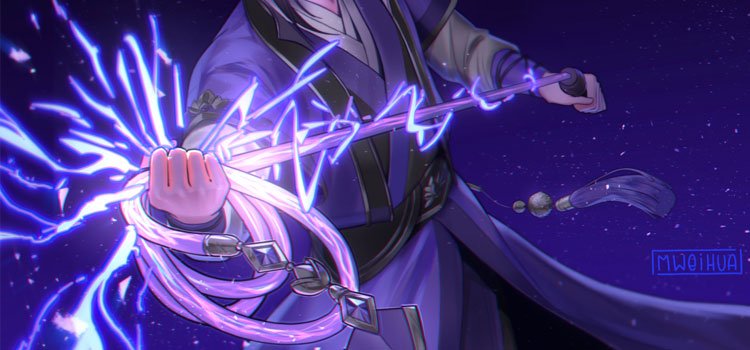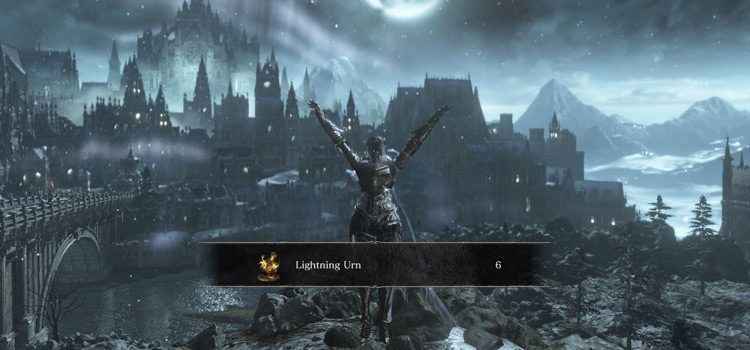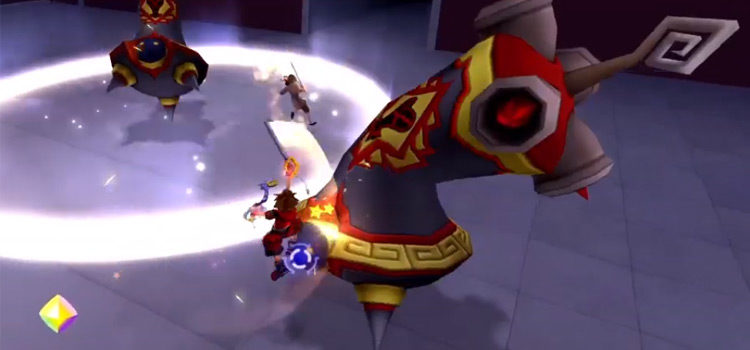Lightning Lure: D&D 5e Spell Guide
This post may contain affiliate links. If you buy something we may get a small commission at no extra cost to you. (Learn more).
Like green-flame blade and booming blade, a few other spells were updated in Tasha’s Cauldron of Everything.
Lightning lure is one of these spells.
Although it was changed significantly less in the update than the blade spells. But let’s take a look and what we’re playing with.
Lightning Lure Spell Details
Type: Evocation Cantrip
Casting Time: One Action
Range: Self (15 ft.)
Components: V
Duration: Instantaneous
When you cast this spell, you make a lasso or whip out of pure lightning. The lightning targets a creature you pick that you can see within 15 feet, and forces it to make a Strength saving throw.
If it fails, it is pulled up to 10 feet directly towards you. If it ends up within 5 feet of you, it takes 1d8 lightning damage, increasing to 2d8 at lvl 5. The damage increases again at 11th and 17th level.
Who Gets It?
Since lightning lure is a cantrip, it’s not too hard to pick it up.
Lightning lure can be found on the artificer, sorcerer, warlock, and wizard spell lists. As usual, because lightning lure is on the wizard spell list, Eldritch Knight fighters and Arcane Trickster rogues have access to it as well.
Arcana Domain clerics learn two wizard cantrips as a 1st level domain feature, giving them a way to learn lightning lure.
High elves can pick this spell for their racial feature.
Bards can learn the spell using their Magical Secrets feature, although they are infinitely more likely to focus on some other spell.
The Magic Initiate and Artificer Initiate feats allow a character of any class to learn a cantrip or two from one of the classes that have lightning lure on their spell list.
Lightning Lure Interactions
Like the green-flame blade and booming blade spells, lightning lure was changed in Wizards of the Coast’s eratta documents in the lead-up to the release of Tasha’s Cauldron of Everything.
Fortunately, lightning lure hasn’t changed much, so there’s only a few things to keep in mind about how the spell interacts with other features.
War Caster
Short version: lightning lure still works with the War Caster feat.
When a creature provokes an opportunity attack from you, the War Caster feat lets you cast a spell instead of making a melee weapon attack. The spell has to normally have a casting time of 1 action and targets only the creature that provoked the opportunity attack.
Lightning lure only damages one creature, which follows the feat’s restrictions, but some confusion comes up over what a range of Self (15 feet) means for the feat.
D&D’s lead rules designer Jeremy Crawford elaborated on how the spells work on Twitter. According to him, Self (15 feet) effectively means that you are the spell’s point of origin, but not necessarily its target.
It’s important to note that opportunity attacks happen right before a creature leaves your reach. In other words, you’ll be using lightning lure on a creature within 5 feet of you, rather than the 15 foot range the spell normally has.
You won’t be able to pull the creature, but it’ll still be within 5 feet of you and will take the lightning damage.
Twinned Spell Metamagic
Before the release of Tasha’s Cauldron of Everything, the spell had a simple range of 15 feet.
Now, however, it has a range of Self (15 feet). Since the spell now (sort-of) has a range of ‘self’, it is ineligible for being used with the Twinned Spell metamagic.
There’s a long conversation to have about the logic of this being a ‘self’ spell, but the important thing is that rules-as-written, it can’t be used with that particular metamagic.
How to Use It
Lightning lure is somewhat unique. There’s a short list of spells that throw a target away from the caster.
There’s an even shorter list of spells that pull the target closer.
Pulling Targets
Lightning lure’s short range makes it primarily a spell used by melee spellcasters, drawing someone closer to the target, ideally within melee range.
This works particularly well for Bladesinger wizards, Eldritch Knight fighters, and (if they can get it) College of Valor bards.
All of these subclasses have an ability that allows them to combine melee attacks with cantrips.
With their unique Extra Attack, a Bladesinger can cast lightning lure, draw in a target, and then hit them with their second attack as part of the Attack action.
Eldritch Knights have War Magic, which would let them cast the spell, and then attack with a weapon as a bonus action.
Valor bards have Battle Magic, although using lightning lure this way requires that the spell be learned using the bard’s Magical Secrets feature.
Pulling Off The Ground
The spell specifies that it just pulls the target 10 feet towards you in a straight line. If you happen to be flying 15 feet above the target, they’re now pulled 10 feet straight up.
There’s some room for inventive uses here, based on your positioning and if you can fly.
In theory, you could use the spell to yank people trying to climb a wall or a tree back to you on the ground.
You could draw someone on a platform above you diagonally down to your own platform, or simply over empty space if you arrange things correctly.
If you have a fly speed, you could use the spell to harass climbers on much higher surfaces, sending mountain climbers or assassins scaling a castle wall hurtling to their deaths by pulling them away from any solid surface.
At that point, the couple d8s of lightning damage is more of an insult on top of the fall damage’s injury.
Emergency Lasso
This one requires a bit of DM fiat.
Technically, opportunity attacks are triggered when a hostile creature leaves your reach.
If you have the War Caster feat, a kind DM might allow you to make an ‘opportunity attack’ when an allied creature falls past or away from you into empty space.
Assuming you get permission and don’t mind dealing a little lightning damage, you could use this spell to grab a falling friend and bring them back onto solid ground.
Clerics
While Arcana Domain clerics can learn the spell, the one who tends to benefit from it most is the Tempest Domain cleric
Because lightning lure deals lightning damage, the spell works with several of the Tempest cleric’s features.
Destructive Wrath allows you to maximize the lightning damage from the spell. You may not want to use this on just a cantrip, but it is always an option.
Thunderbolt Strike has some interesting uses for the spell. Lightning lure pulls a creature 10 feet towards you, while the Thunderbolt Strike feature pushes it 10 feet back.
You would yank the creature towards you, damaging it, before sending it back to where it was originally.
This is actually rather useful.
A number of area of effect spells deal damage when a creature enters the area for the first time on a turn. By pulling a creature already in that area and then pushing it back into the damaging zone, you can trigger those area spells again.
Ideally, you’re now dealing lightning lure’s damage on top of the damage from something like wall of fire or blade barrier.
The downside is that lightning lure is on the sorcerer, wizard, warlock, and artificer lists.
While a cleric could learn the spell through racial features, multiclassing, or feats, the spell isn’t a cleric spell.
And it will always use your Charisma or Intelligence modifier to determine the DC.
If you happen to have a decent score in one of those two stats, it might still be worth it to take the spell, if you can make sure your spell DC for it is high enough.
Arcana Domain clerics that take the spell can cast it with Wisdom, but won’t gain the benefit of Thunderbolt Strike.
Warlocks
Warlocks that don’t take the Pact of the Blade won’t really want to take lightning lure.
Eldritch blast has an invocation called Grasp of Hadar that allows you to drag one creature you hit with the spell 10 feet closer to you.
The only reason to use lightning lure over eldritch blast is that since lightning lure doesn’t require an attack roll, it can be used against creatures within 5 feet … which isn’t generally the situation you want to be using lightning lure in the first place.
If you are a melee warlock, aren’t planning to learn eldritch blast, and you want a method to drag enemies closer to you and your melee buddies, it can be a good cantrip to have.
Artificers
Armorer and Battle Smith artificers can find uses for this spell.
While they don’t get anything similar to the Eldritch Knight’s War Magic feature, Guardian Armorers might find a use for this spell in dragging an enemy closer to them.






